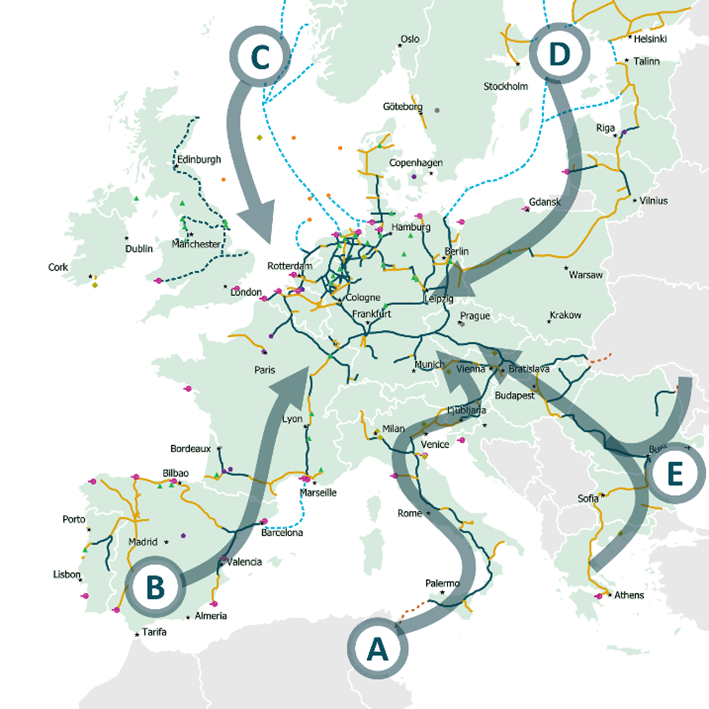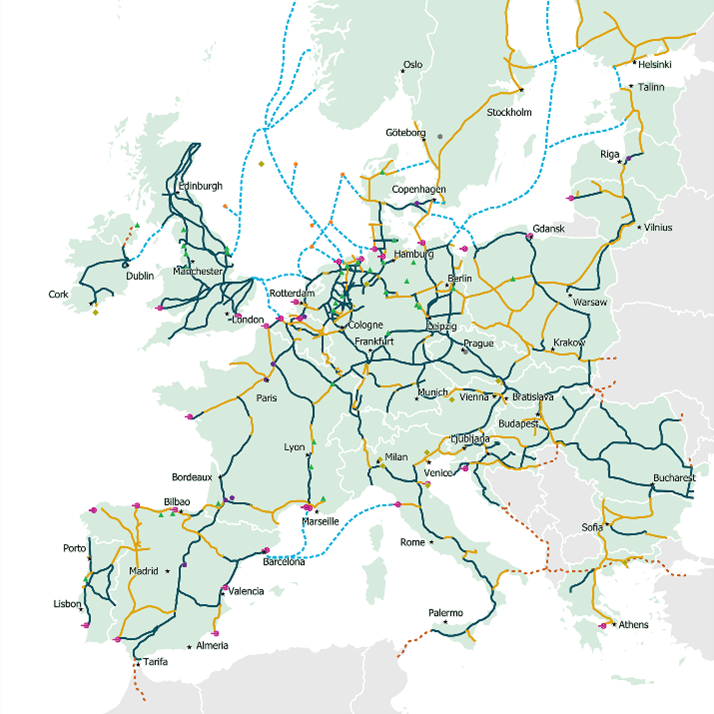Hydrogen vision
Hydrogen can be used both as a feedstock and fuel. It is storable and has many possible applications across the industry, transport, power, and buildings sectors. Most importantly, hydrogen does not emit CO2 at the point of use and can be produced with a very low GHG emission footprint. Thus, it offers a solution to decarbonise industrial processes and economic sectors where reducing carbon emissions is both urgent and hard to achieve.
Renewable and low carbon hydrogen has received growing attention in Europe and around the world. In its European hydrogen strategy, the European Commission makes hydrogen as a key element to achieving the EU’s target of net zero emissions by 2050.
The role of hydrogen is further underlined by the REPowerEU plan, established by the European Commission in 2022. The plan targets 10 Mt of domestic renewable hydrogen production, as well as up to 10 Mt on hydrogen imports by 2030.
The REPowerEU plan mentions several import corridors by pipeline for hydrogen produced outside the EU. Achieving the REPowerEU targets by 2030 and a fully decarbonised European energy system at the latest by 2050 is ambitious. It will require a rapid deployment of domestic hydrogen production capacities, hydrogen storage and import infrastructure as well as a pan-European hydrogen transmission network.
The SunsHyne Corridor contributes to the realisation of the corridors mentioned in REPowerEU and the European Commission is planning to support the establishment of these hydrogen import corridors within the Trans-European energy networks framework with several billion EUR. We believe that the SunsHyne Corridor initiative will contribute significantly to the realization of this vision.
Hydrogen transport
The European Hydrogen Backbone (EHB) initiative, consisting of 31 transmission system operators, is driven by the vision to connect regions through a series of hydrogen-dedicated infrastructure pipelines throughout Europe. This infrastructure, consisting of large parts of existing and newly built pipeline networks, will ensure access to hydrogen and provide the groundwork to accelerate the hydrogen market in Europe. In line with the tenets of the REPowerEU plan, the EHB has the potential to promote system resilience, energy independence, security of supply and create a low-carbon and renewable hydrogen market in Europe.
In May 2022, the EHB presented five large-scale pipeline corridors in Europe which are in line with the hydrogen supply targets set out in the EU Commission’s REPowerEU plan for 2030. Those five hydrogen corridors are North Africa and Southern Europe, Southwest Europe and North Africa, North Sea, Nordic and Baltic regions as well as Eastern and South-eastern Europe. The identified corridors will allow for the highest levels of efficiency and cost effectiveness for transporting large volumes of hydrogen to demand centres across Europe.
Connecting regions of cost competitive green hydrogen potential in Tunisia and Algeria through Italy with demand centers in Central Europe, the SunsHyne Corridor strongly contributes to the development of the corridor North Africa and Southern Europe. The envisaged hydrogen infrastructure of the project partners would contribute to the decarbonization of hard-to-abate industries along the route in Italy, Central Europe, and Germany.
Detailed information about the EHB and its work can be found here: The European Hydrogen Backbone (EHB) initiative | EHB European Hydrogen Backbone




